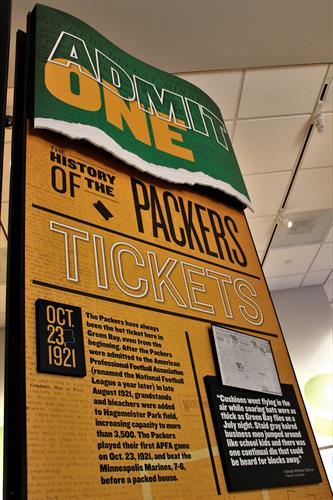
Admit One
The History of the Packers Tickets
October 23, 1921
The Packers have always been the hot ticket here in Green Bay, even from the beginning. After the Packers were admitted to the American Professional Football Association (renamed the National Football League a year later) in late August 1921, grandstands and bleachers were added to Hagemeister Park field, increasing capacity to more than 3,500. The Packers played their first APFA game on Oct. 23, 1921, and beat the Minneapolis Marines, 7-6, before a packed house.
"Cushions went flying in the air while soaring hats were as thick as Green Bay flies on a July night. Staid gray haired business men jumped around like school kids and there was one continual din that could be heard for blocks away." - George Whitney Calhoun, Packers co-founder
Early Days of Tickets in Green Bay
Passing the Hat
In 1919, with no fence around the Hagemeister Park field, co-founder George Whitney Calhoun and others would pass their hats, taking up a collection among the fans in attendance.
In 1920, the Packers got permission from the Hagemeister Realty Co., which owned the Hagemeister Park property, to build a temporary fence around the field so they could charge admission.
Green Bay Press-Gazette
Before the 1923 season started, Andrew Turnbull, one of the Press-Gazette's original owners, took the lead in creating the Green Bay Football Corporation and the Press-Gazette's Cherry St. building became the Packers' unofficial ticket office.
"The office staff was always ready for a timeout to sell Packers tickets even while handling want ads or legal notices," Calhoun wrote years later in his column, "Cal's Comments."
Legion Park
In 1936, the Packers set up a ticket office in the Legion Building, which faced Walnut St. and stood closer to the northwest corner of the property known as Legion Park. The building originally had been built in 1890 as an annex to the old courthouse. The ticket office operated out of the building until they moved into an office on South Washington St. in 1949.
Packers Office Building
The Packers moved into the south side of the building at the northeast corner of Washington and Crooks streets in June 1949 and continued to occupy it until a new administration building was constructed at the north end of what is now Lambeau Field in 1963.
They designed the facilities so that the ticket office would be in the front part of the first floor and easily accessible. The Packers were still playing in old City Stadium at the time and were financially dependent on ticket sales. The coaches worked either in the basement or on the second floor.
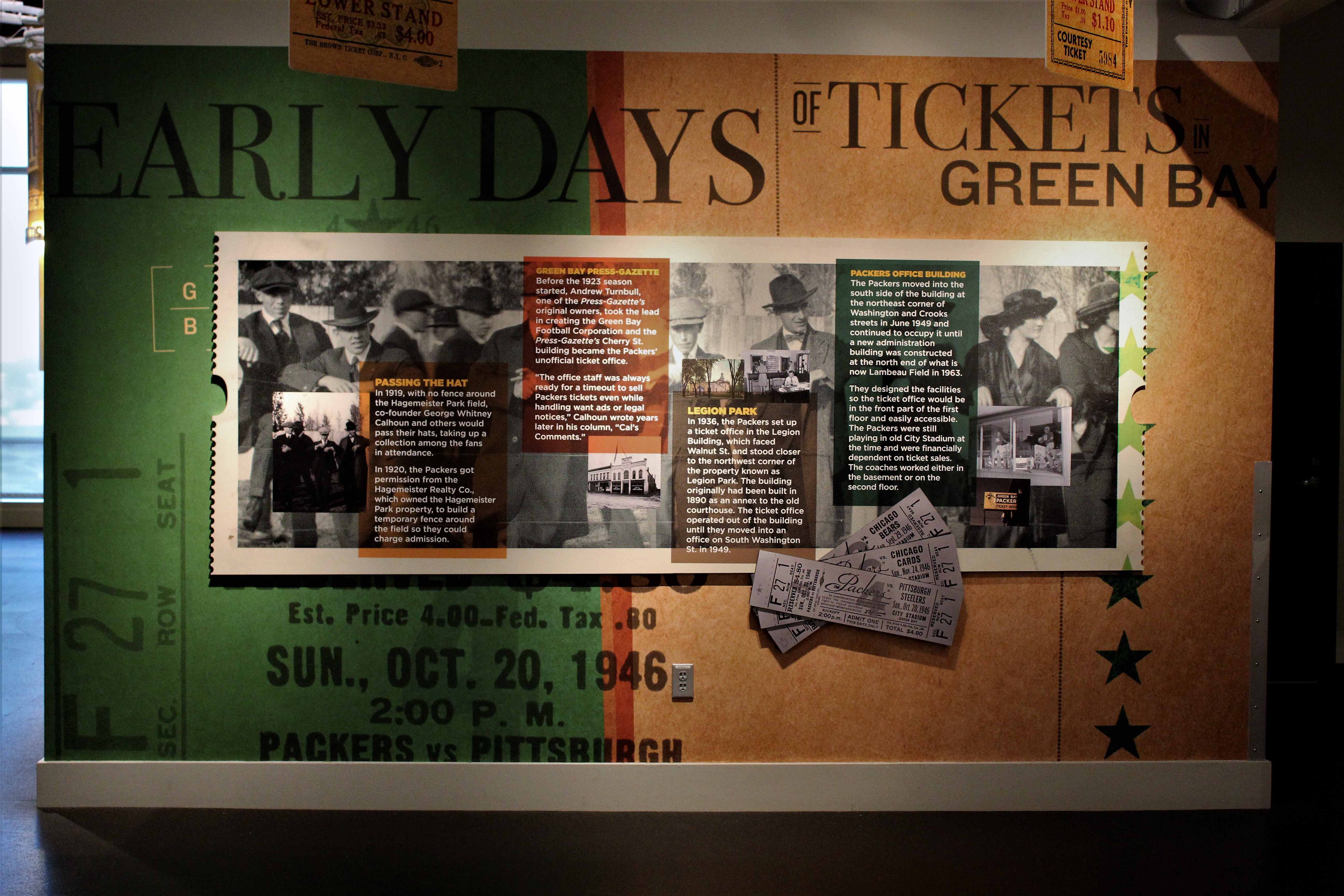
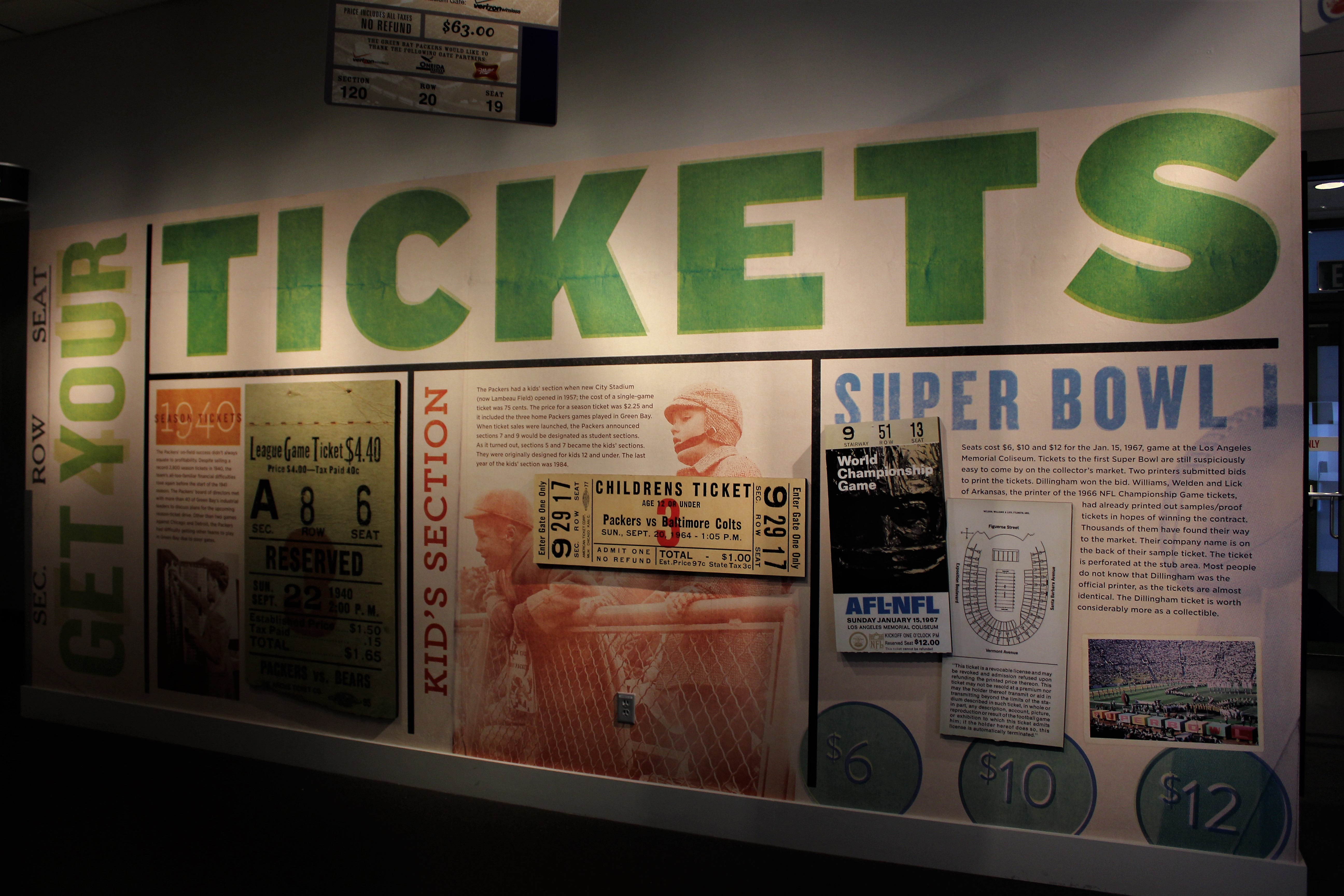
Get Your Tickets
1940 Season Tickets
The Packers' on-field success didn't always equate to profitability. Despite selling a record 2,800 season tickets in 1940, the team's all-too-familiar financial difficulties rose again before the start of the 1941 season. The Packers' board of directors met with more than 40 of Green Bay's industrial leaders to discuss plans for the upcoming season-ticket drive. Other than two games against Chicago and Detroit, the Packers had difficulty getting other teams to play in Green Bay due to poor gates.
Kid's Section
The Packers had a kids' section when new City Stadium (now Lambeau Field) opened in 1957; the cost of a single-game ticket was 75 cents. The price for a season ticket was $2.25 and it included the three home Packers games played in Green Bay. When ticket sales were launched, the Packers announced sections 7 and 9 would be designated as student sections. As it turned out, sections 5 and 7 became the kids' sections. They were originally designated for kids 12 and under. The last year of the kids' section was 1984.
Super Bowl I
Seats cost $6, $10 and $12 for the Jan. 15, 1967, game at the Los Angeles Memorial Coliseum. Tickets to the first Super Bowl are still suspiciously easy to come by on the collector's market. Two printers submitted bids to print the tickets. Dillingham won the bid. Williams, Welden and Lick of Arkansas, the printer of the 1966 NFL Championship Game tickets, had already printed out sample/proof tickets in hopes of winning the contract. Thousands of them have found their way to the market. Their company name is on the back of their sample ticket. The ticket is perforated at the stub area. Most people do not know that Dillingham was the official printer, as the tickets are almost identical. The Dillingham ticket is worth considerably more as a collectible.
Sorry This Event is Sold Out
Sold out since 1960 and on a season-ticket basis since 1961 (342 consecutive regular-season games not including replacement games, at the start of the 2019 season), Lambeau Field was not the Packers' only regular-season home; until 1995, the team played four regular-season games in Milwaukee. After moving all games to Green Bay, the team maintained two separate ticket packages, including one for former Milwaukee ticket-holders.
"Gold" ticket holders (made up primarily of former Milwaukee season patrons) have a three-game package consisting of the annual Midwest Shrine preseason contest plus the second and fifth regular-season games each year. "Green" season customers (made up of original Green Bay ticket holders) have a seven-game package consisting of the annual Bishop's Charities preseason game and the remaining six regular-season games.
At the start of the 2019 season, the Packers had more than 137,000 names on their season-ticket waiting list between both ticket packages.
Additionally, Brown County residents without season tickets have a chance to purchase four tickets each year through the Brown County ticket drawing, with 2,500 bowl tickets available for residents for each game.
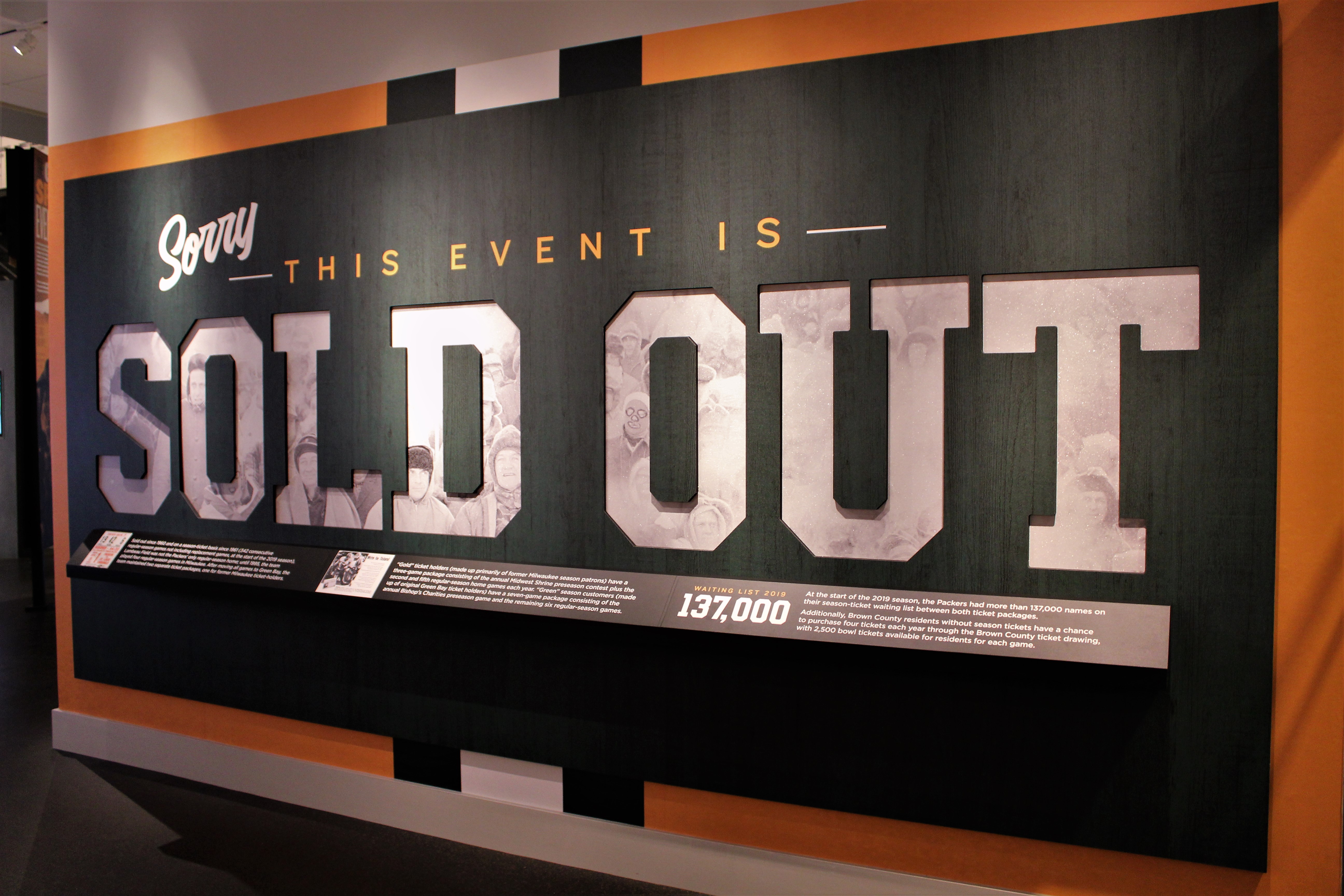
Lambeau Field Expansions
Bowl Expansions
- 1961: Added 6,519 seats to create a capacity of 38,669
- 1963: Added 3,658 temporary bleacher seats to increase capacity to 42,327
- 1965: Removed 3,658 temporary bleacher seats and added 12,183 permanent seats to increase capacity to 50,852
- 1970: Added 5,411 seats to create a capacity of 56,263 and full enclosure of the stadium bowl
Suite & Club Seats
- 1985: Created original 72 suites that added 663 seats, increased ticket capacity to 56,926
- 1990: Added 2,617 total seats with 36 new suites and 1,920 club seats
- 1995: Enclosed the north end zone with 90 more suites, adding an additional 1,347 seats
Renovation & Redevelopment
- 2001-03: Added 12,032 seats, pushing capacity to 73,094
- 2014: Added the South End expansion and the addition of standing-room-only areas to raise capacity by 8,341 to 81,441
Future Tickets
A mobile ticket, will be the digital ticket equivalent of a paper ticket, and the wave of the future in the National Football League. Digital ticketing will make it easier for consumers, by simply presenting their ticket via their smart phone. The evolution of the digital ticket office will likely only be the beginning. Technology continues to provide future enhancements.
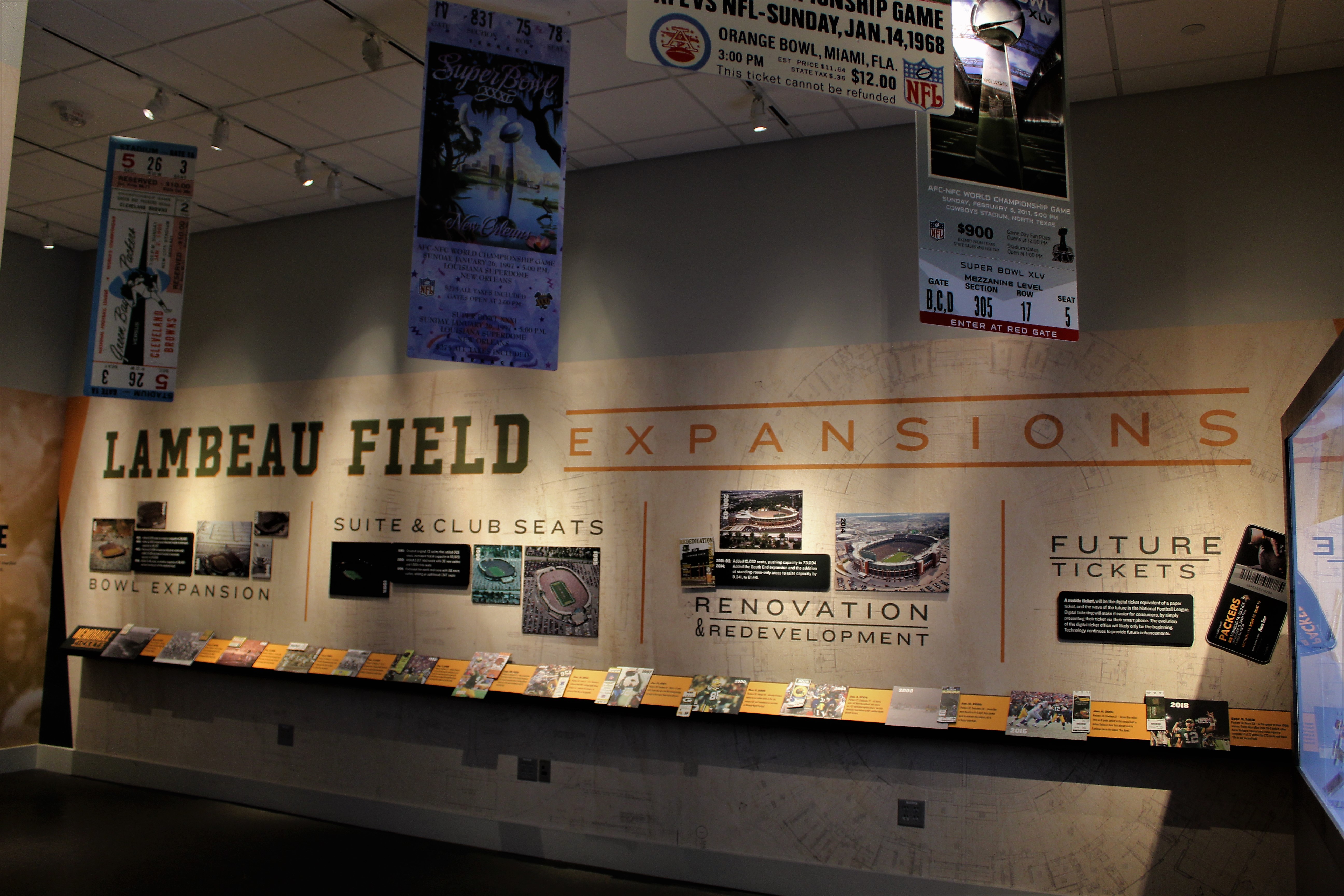
Memorable Tickets
Sept. 29, 1957: Packers 21, Bears 17 - New City Stadium is dedicated as Babe Parilli hits Gary Knafelc on a fourth-quarter TD pass.
Sept. 27, 1959: Packers 9, Bears 6 - Vince Lombardi wins his first game and gets carried off the field after a Jim Taylor touchdown and Dave Hanner safety.
Dec. 31, 1961: Packers 37, Giants 0 - The first title game in Green Bay and Lombardi's first NFL crown. The Packers total 345 yards on the league's top-ranked defense.
Oct. 7, 1962: Packers 9, Lions 7 - Herb Adderley's interception leads to Paul Hornung's game-winning field goal in the final seconds of the "Run to Daylight" game.
Jan. 7, 1966: Packers 23, Browns 12 - In a snowy 1965 NFL Championship Game, Paul Hornung and Jim Taylor combine for 201 yards on the ground.
Dec. 31, 1967: Packers 21, Cowboys 17 - In -13 temperatures (-46 wind chill), Bart Starr scores on a sneak in the final minute, ending a 12-play drive in the Ice Bowl.
Nov. 5, 1989: Packers 14, Bears 13 - Sterling Sharpe's 14-yard fourth-quarter touchdown catch knots the contest with 32 seconds left, after instant replay official Bill Parkinson overturns the original call on the field.
Sept. 20, 1992: Packers 24, Bengals 23 - New acquisition Brett Favre comes off the bench to erase a 20-7 fourth-quarter deficit, finding Kitrick Taylor for a 35-yard touchdown with 13 seconds left.
Memorable Tickets
Dec. 31, 1994: Packers 16, Lions 12 - Fritz Shurmur's defense holds NFL rushing leader Barry Sanders to -1 yard on 13 attempts, to advance Green Bay in the playoffs.
Jan. 12, 1997: Packers 30, Panthers 13 - With a -17 wind chill, Green Bay wins the NFC championship, earning its first Super Bowl trip in 29 years.
Nov. 6, 2000: Packers 26, Vikings 20 - Antonio Freeman makes an incredible catch in the rain, scores a 43-yard touchdown in overtime on Monday Night Football.
Jan. 4, 2004: Packers 33, Seahawks 27 - Al Harris picks off Matt Hasselbeck and scores on a 52-yard interception return, the first defensive touchdown in NFL sudden-death playoff history.
Jan. 12, 2008: Packers 42, Seahawks 20 - Green Bay spots Seattle a 14-0 lead, then storms back to outscore the visitors, 42-6, as heavy snow falls.
Jan. 11, 2015: Packers 26, Cowboys 21 - Green Bay rallies from an 8-point deficit in the second half to defeat Dallas in their first playoff visit to Lambeau since the fabled "Ice Bowl."
Sept. 9, 2018: Packers 24, Bears 23 - In the opener of their 100th season, Green Bay rallies from a 20-0 deficit, after Aaron Rodgers returns from a knee injury to complete 17 of 23 passes for 273 yards and three TDs in the second half.
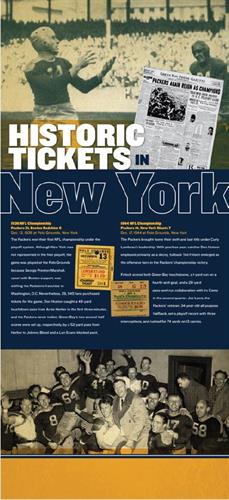
Historic Tickets in New York
1936 NFL Championship
Packers 21, Boston Redskins 6
Dec. 13, 1936 at Polo Grounds, New York
The Packers won their first NFL championship under the playoff system. Although New York was not represented in the first playoff, the game was played at the Polo Grounds because George Preston Marshall, upset with Boston support, was shifting the Redskins franchise to Washington D.C. Nevertheless, 525 fans purchased tickets for the game. Don Hutson caught a 48-yard touchdown pass from Arnie Herber in the first three minutes, and the Packers never trailed. Green Bay's two second-half scores were set up, respectively, by a 52-yard pass from Herber to Johnny Blood and a Lon Evans blocked punt.
1944 NFL Championship
Packers 14, New York Giants 7
Dec. 17, 1944 at Polo Grounds, New York
The Packers brought home their sixth and last title under Curly Lambeau's leadership. With peerless pass-catcher Don Hutson employed primarily as a decoy, fullback Ted Fritsch emerged as the offensive hero in the Packers' championship victory.
Fritsch scored both Green Bay touchdowns, a 1-yard run on a fourth-and-goal, and a 28-yard pass-and-run collaboration with Irv Comp in the second quarter. Joe Laws, the Packers' veteran 34-year-old all-purpose halfback, set a playoff record with three interceptions, and rushed for 74 yards on 13 carries.
The Greatest Sporting Event in Green Bay History
The Packers beat Red Grange's New York Yankees, 13-0, at old City Stadium on Oct. 23, 1927. Grange was a special gate attraction in the days when college stars rarely turned to pro football. Packers fans clamored for tickets to the game and advanced sales smashed every record for the Green Bay Football Corporation. Spectators numbering more than 11,000 turned out for the biggest professional football crowd to ever witness a game in Green Bay at the time. Grange was unable to play in the game due to an injury suffered the previous week against the Bears.
Vern Lewellen had a field day as the punter, and allowed Green Bay to control field position. Pid Purdy scored the first touchdown of the game for the Packers on a five-yard rush.
"The greatest sport event that Green Bay has ever experienced will be on tap Sunday afternoon at the City Stadium when Red Grange's New York Yankees and the Green Bay Packers have it out in a National Football League battle ..." - Green Bay Press-Gazette, Oct. 22, 1927
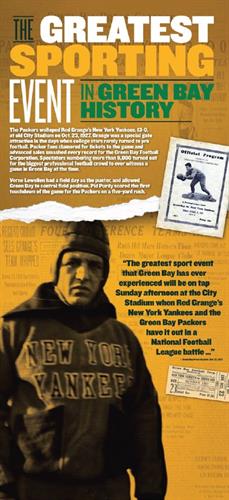
Explore Artifacts
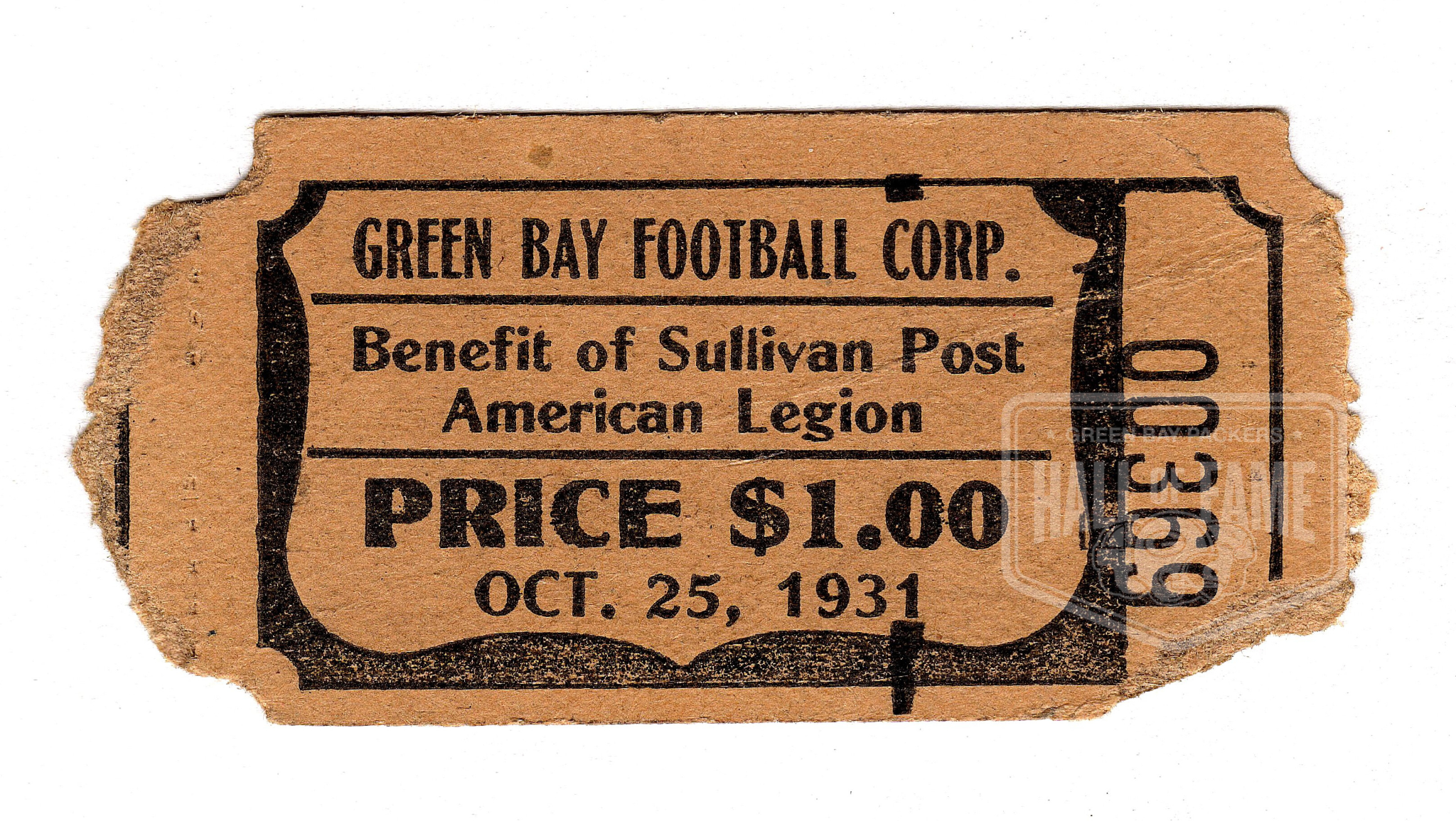
Oct. 25, 1931 Green Bay Packers Ticket
The Packers defeated the Providence Steam Roller, 48-20, at City Stadium.
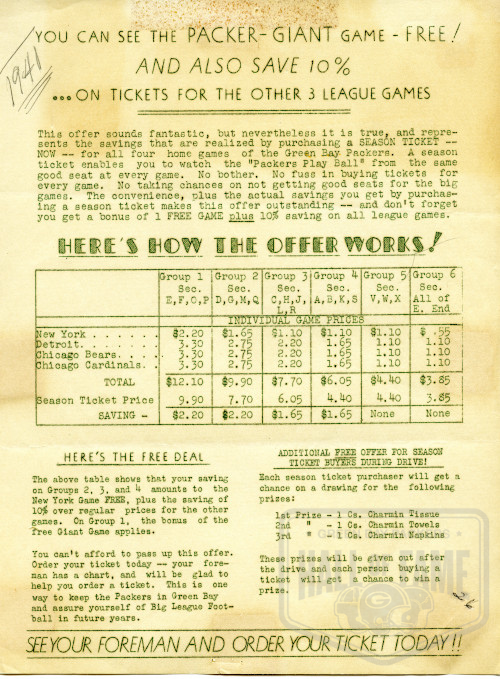
1941 Packers Season Ticket Information Sheet
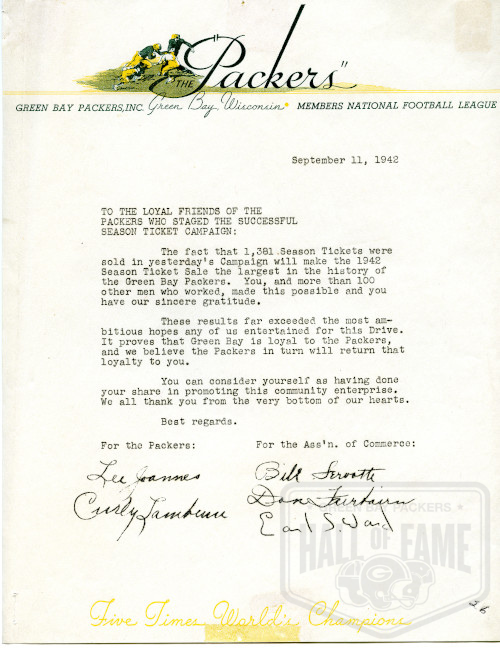
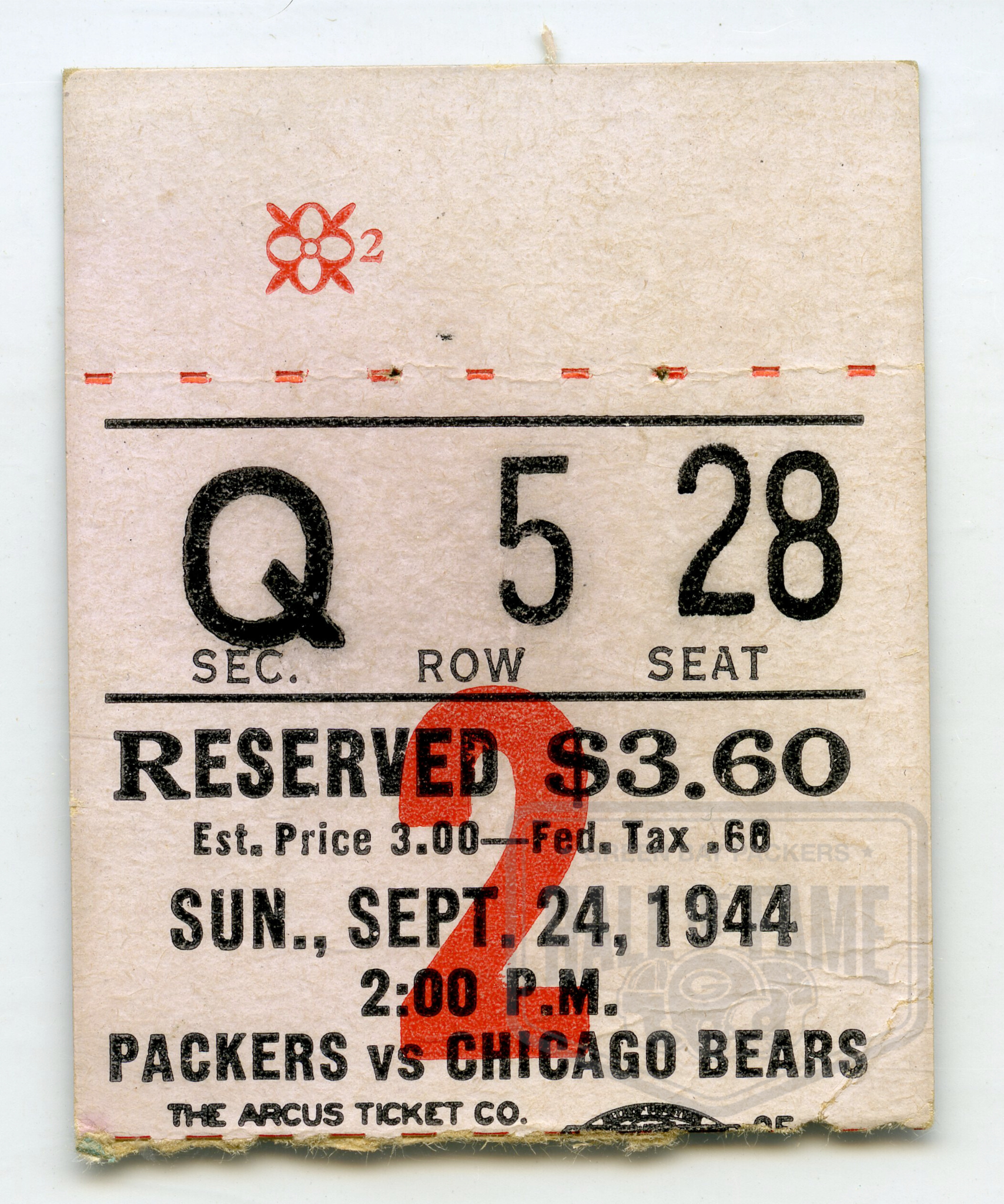
Sept. 24, 1944 Green Bay Packers Ticket
The Packers defeated the Chicago Bears, 42-28, at City Stadium.

Sept. 20, 1964 Green Bay Packers Children's Ticket
This section was reserved tor youth 12 and under.

Jan. 2, 1966 1965 NFL Championship Ticket
The Packers defeated the Cleveland Browns, 23-12, at Lambeau Field.
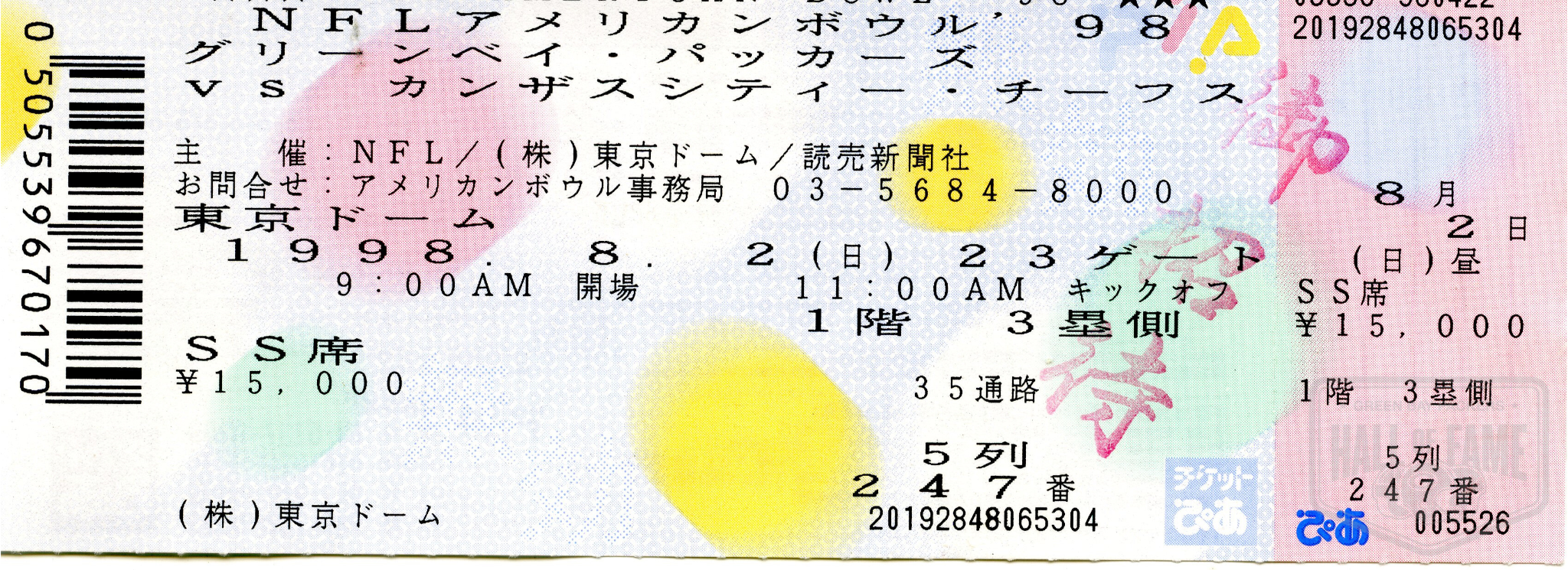
Aug. 2, 1998 American Bowl Ticket
The Packers-Chiefs preseason ticket was written in Japanese
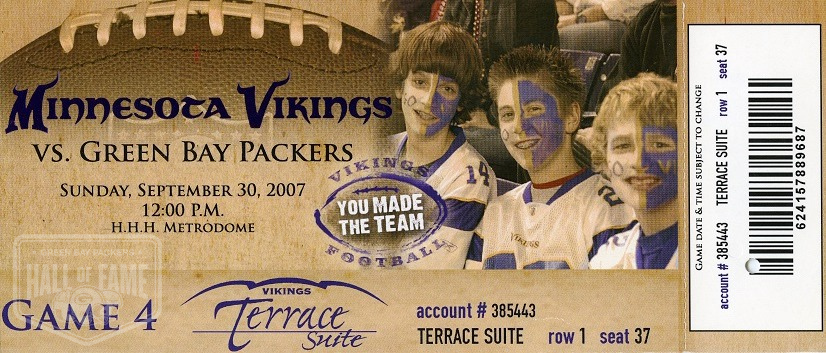
Sept. 30, 2007 Minnesota Vikings Ticket
Brett Favre set the NFL's all-time record for touchdown passes.

Dec. 26, 1993 Lambeau Leap Ticket
The Packers defeated the Los Angeles Raiders, 28-0, at Lambeau Field.
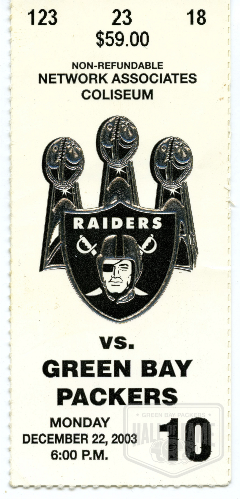
Dec. 22, 2003 Oakland Raiders Ticket - on loan from D Milliren
After the passing of Brett Favre's father, Favre provided a thrilling performance on Monday Night Football.
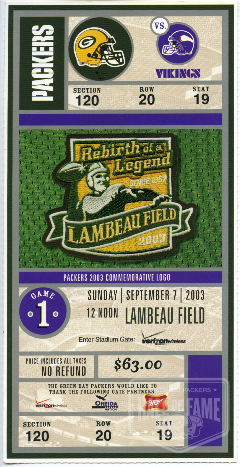
Sept. 7, 2003 Green Bay Packers Ticket - on loan from D Milliren
The rededication of Lambeau Field took place in the season opener with the Packers taking on the Minnesota Vikings.

